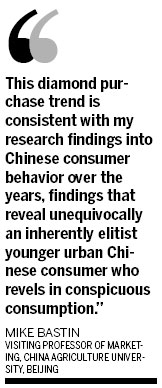Money
Diamond market shines bright
By Mark Hughes (China Daily)
Updated: 2010-10-11 10:09
 |
Large Medium Small |
|
 |
|
Johan Dippenaar, chief executive officer of Petra Diamonds Ltd, poses with the 'Cullinan Heritage' diamond in this undated handout photograph released to the media on Feb 26. The diamond the size of a chicken egg unearthed in South Africa last year was sold for a record price to Hong Kong's Chow Tai Fook Jewellery Co Ltd, according to Petra Diamonds Ltd, which discovered the gem at its Cullinan mine. [Photo/Agencies]
|
Nation becoming a major player in international trade of precious gems
HONG KONG - Mention diamonds and the chances are people will think of South Africa, home to the gemstone-rush in the late 1800s after a young shepherd named Erasmus Jacobs found a small white pebble along the bank of the Orange River. That white pebble turned out to be a 21.25 carat diamond, dubbed the "Eureka".

In 1871, an even larger 83.50 carat diamond was found on the slopes of Colesberg Kopje. After that, miners began arriving by the thousands, and the hill began to disappear, replaced by a gigantic open-pit mine. Speculators began searching elsewhere in the country and in 1902 the Cullinan diamond mine in Gauteng province to the north was opened, yielding in 1905 the largest diamond yet found: the giant 3,106.75-carat Cullinan Diamond.
Moving on more than a century and one very fortunate Chinese lady is likely to be the beneficiary of jewellery cut from the largest stone quarried from that mine in recent years. In February this year, Hong Kong-based Chow Tai Fook Jewellery Company Ltd paid a world record $35.3 million for a 507-carat rough diamond, the 19th largest ever found, to miner Petra Diamonds, which now owns the Cullinan mine near Pretoria.
Cheng Yu-Tung, chairman of Chow Tai Fook Group, who is known as the "King of Diamonds", was pleased with the acquisition: "This spectacular and high-quality diamond is very rare and exceptional," he said. "Chow Tai Fook Jewellery's repeated success in acquiring world-renowned diamonds is backed by Chow Tai Fook Group's strength and endless pursuit of perfection in providing our customers with quality products." The company plans to handcraft the stone into the finest round diamond of 120 carats. It says it has not yet decided whether to sell it on. However, the sale underlined the strength of the market in the Chinese mainland for magnificent diamonds. Jewellers told China Daily that Chow Tai Fook was likely to find a buyer in the mainland for the finished piece or pieces in the country, one of the worlds largest and fastest growing diamond markets.
"The next big market for rare diamonds will be China," said Marwan Chatila, owner of Chatila, a fine jeweller in London's Bond Street, which was one of the bidders for the Cullinan Heritage.
"If the Chinese boom has legs, it will become very hard to find such diamonds. They will be sold there."
The finished stone would be far more valuable than the rough diamond.
Marijan Dundek, a leading authority on gemstones who recently published a new edition of his book entitled "Diamonds", said the rough stone could undergo months of examination to test its clarity.
"The key factors will be the clarity and whether there are any inclusions, and on this basis a decision will be made on how to cut the stone," he said.
AIM-listed Petra found the gem last September at its 74 percent-owned Cullinan mine in South Africa, which it bought from the world's largest diamond producer, De Beers, in 2007.
Chow Tai Fook has been in the jewellery business for more than 80 years and is one of the largest and most famous jewellery brands in the mainland. It owns two diamond cutting facilities in South Africa and one diamond cutting facility in the mainland, as well as jewellery design and manufacturing plants across the mainland and Hong Kong which produce more than 7 million pieces of jewellery a year. The company's 1,000 jewellery retail outlets are spread across the mainland and Hong Kong, Macao, Taiwan and Malaysia and employ more than 30,000 staff. On the back of high Chinese demand it plans to increase the number of outlets by 2,000 by 2020. Current annual sales exceed HK$30 billion ($3.9 billion) and its market value exceeds HK$100 billion.
According to De Beers managing director Gareth Penny, Chinese diamond demand could reach the same level as the US, the biggest consumer, in the next decade. "What we're now seeing, with China growing as rapidly as it, is annual double-digit growth compounded over a period of five years," he said.
Twenty years ago, few Chinese brides received diamond engagement rings but now nearly half of couples getting married in Beijing, Shanghai and Guangzhou are buying them. Aggressive efforts by De Beers in the 1990s, including TV advertising and wedding sponsorships, boosted sales. De Beers forecast China would account for 16 percent of global diamond demand by 2016, up from about 6 percent last year.
"Prices are not going to go down. They will only go up," said author Dundek. "Prices, especially for color diamonds, are going through the roof."
Mike Bastin, a visiting professor of marketing at China Agriculture University in Beijing, said: "Diamonds are not bought for any aesthetic value at all. They merely serve as the latest status symbol in Chinese society: a tangible sign of an increasingly hierarchical and solipsistic Chinese consumer culture.
"This diamond purchase trend is consistent with my research findings into Chinese consumer behavior over the years, findings that reveal unequivocally an inherently elitist younger urban Chinese consumer who revels in conspicuous consumption. Furthermore, recent research findings from a research study with the psychology department of Peking University uncovered conclusively that increasing affluence inevitably leads to increased self-importance and consequent self-reward. This would appear to explain why Chinese consumers increasingly buy diamonds for themselves. My consumer research among the Chinese very much aims to foresee the future as well as understand the present. My research findings appear to suggest that as China develops and the Chinese economy matures, so will the Chinese consumer, especially the relatively sophisticated balinghou (post-1980s) and jiulinghou (post 1990s) generations. This current fixation with diamonds and other luxury brands may, therefore, represent only a stage in the development of the Chinese consumer's mentality."
Meanwhile, exports of polished diamonds from Antwerp, Europe's diamond capital, to the mainland and Hong Kong increased 55 percent to $737 million in the first three months of this year, the Antwerp World Diamond Center (AWDC) revealed, making the mainland and Hong Kong the world's biggest buyer of the gems from the Belgian city.
|
||||
"We have a lot of competition so we must position ourselves to attack in China and win in China," said dealer Mickey Weinstock, who says his company's $50 million annual sales are now almost only to Chinese retailers.
The Antwerp-based International Gemological Institute, which trains people to analyze, grade and price diamonds, is expanding its staff in China from just five to 200 over the next few years.
However, China is not solely an importer of diamonds. Last year a large diamond mine was found in Wafangdian district in Dalian, Liaoning province. It is estimated to contain 210,000 carats of precious stones and diamonds of a higher quality than those found in South Africa, according to Chinese gemologists. It is the only large-scale diamond mine found in China over the past three decades, said Yu Wenli, director of the Mineral Geological Exploration Bureau.
Guangdong is emerging as a competitor to India as the world's top diamond cutting and polishing center thanks to low labor costs, skilled workers and the tax-free status of imported rough diamonds and exported polished rocks.



